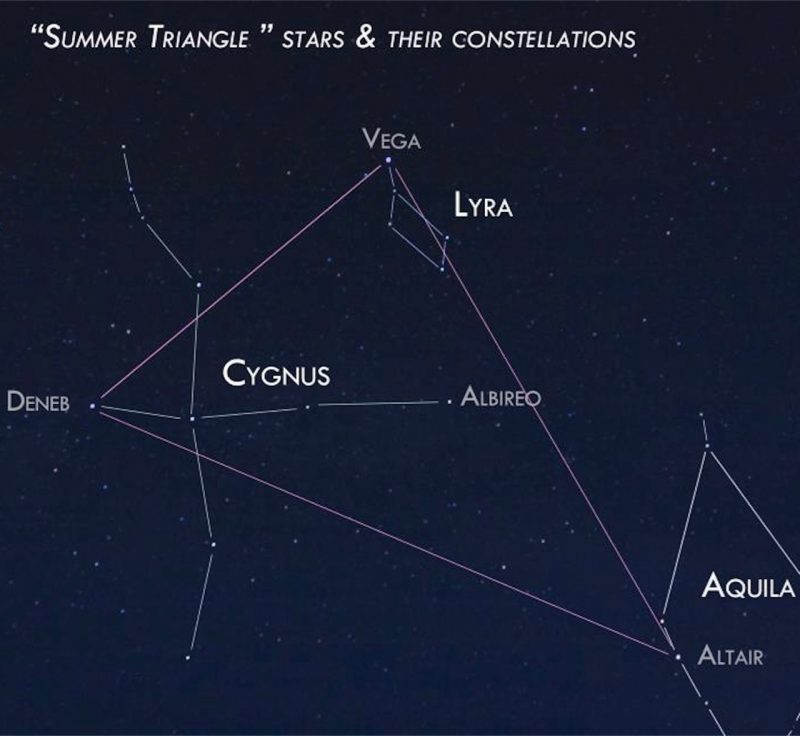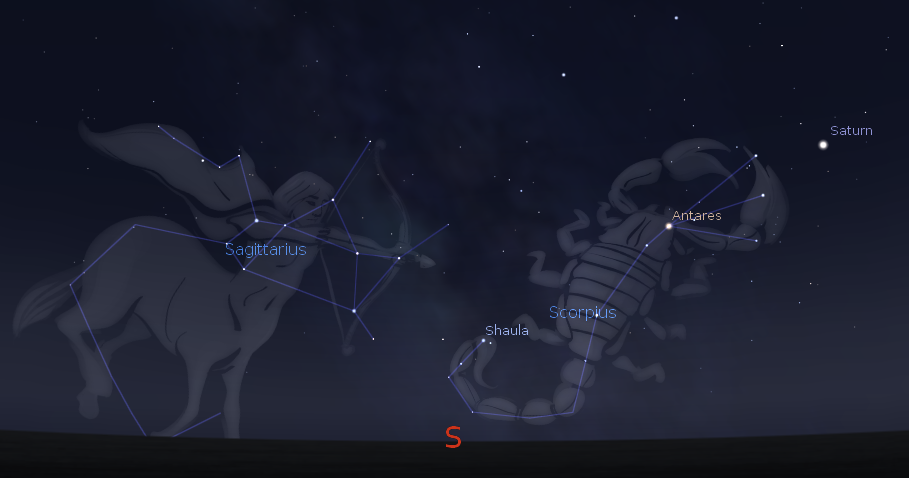70 Falmouth Street Portland, Maine 04103
(207) 780-4249 usm.maine.edu/planet
43.6667° N 70.2667° W
Altitude: 10 feet below sea level
Founded January 1970
2021-2022: I
"We'll leave the night on for you."
THE DAILY ASTRONOMER
Wednesday, September 1, 2021
Beyond the Dots
The Daily Astronomer has returned. If you're new to us, welcome. If not, welcome back. Ordinarily, the first article of the new school year focuses on the September night sky calendar. Of course, as we have all learned within the last eighteen months, we've depleted our stock of ordinary years. This school year begins in a lovely and appropriate place: our star dome theatre.
Above us we observe a beautiful array of dots arranged to replicate the night sky's stellar configuration. There, high in the east, we see the Summer Triangle

Sagittarius the archer and his fearsome companion Scorpius the scorpion creep along the southern sky:

Naturally, Ursa Major and Ursa Minor, the Big and Little Dippers, respectively, pursue each other along a wide circumpolar path through the northern sky.

Naturally, none of these are real: just faint imitations projected onto the half-shell that we've bewitched to resemble the night sky. However, we begin our DA school year here in this quaint, subterranean dome because the night sky serves as our shore: the dots beyond which exists a wondrous and complex cosmos that humans have only begun to fathom. Moreover, it's possible that aspects of our Universe shall forever remain unknown despite our most ardent efforts to demystify it. After all, no cosmologist truly yet knows what transpired at the very first moment of creation 13.8 billion years ago.
However, humans have learned much about physical reality, particularly within the last century. A mere hundred years ago, the notion of galaxies beyond the Milky Way was a matter of fierce debate. Now, the existence of billions of galaxies is an established fact. Thirty years ago, we still weren't sure if planets revolved around other stars. Some astronomers even proposed that planet formation was exceedingly rare, formed out of gases that stars drew out of each other during infrequent close encounters. Now, after having discovered more than 4800 exo-planets, or planets in orbit around other stars, astronomers know that planet formation is generally a natural consequence of star formation. Planets coalesce out of a star's peripheral gaseous disc. Our Milky Way Galaxy, home to more than 400 billion stars, could also harbor as many as one trillion planets. (To put that number into perspective, one trillion seconds equals 32,000 years!) Multiply the number of galaxies by the number of planets likely within those galaxies and the resultant array of worlds staggers our imaginations.
Moreover, as we also now know, star formation hasn't stopped. In fact, the cosmic star formation machines are whirring on all eight cylinders: 3,000 - 20,000 stars are born every second through the Universe. Even at the low end of this range, the fecundity is stunning. By "born," we mean the moment when the ferocious thermonuclear core ignites inside the star to begin transmuting hydrogen into helium and energy: the energy that powers the star.
Energy!
By the rather uninspiring physics definition, energy is the ability to do work. In reality, energy animates the Universe. A ceaseless exchange of energy that never disappears from the cosmos, but merely changes form. The minute energy you need to blink, breathe, and tap your fingers on the desk originated in the primordial Big Bang event. In fact, the particles comprising your body are themselves merely crystallized forms of energy. You are fashioned of the radiant energy that once pervaded the infant cosmos.
Beyond the dots of our night sky, humans discovered a rapidly expanding and prodigiously creative Universe containing more stars and galaxies than one could count in a thousand lifetimes. We also realized that apart from being mere observers of the stars, we are descended from the stars.
You are part of the Universe that enables the Universe to reflect on itself.
The Daily Astronomer task is to meander through space-time from the night sky to the outer depths and even beyond: into the realm where, perhaps, Universes are spawned in great profusion out of a hyper-dimensional space-time foam: a concept once believed to have been the sole reserve of science-fiction authors. During the DA's school year, we'll explore constantly anywhere our mood takes us: even into parallel Universes, themselves.
We'll return to the dome in mid-July when the DA school year ends. According to some quantum theorists, we are already there at that point in space-time. However, our conscious minds haven't yet reached that point. By this notion, everything in the past, present and future exists simultaneously. That is yet another bizarre concept that the Universe might have learned about itself through the act of deep human contemplation. Of course, out beyond the dots innumerable other species might be developing their own natural philosophies whilst living on their own star-orbiting spheres. We just don't know....yet.
Welcome to another DA school year.
To subscribe or unsubscribe from the Daily Astronomer: